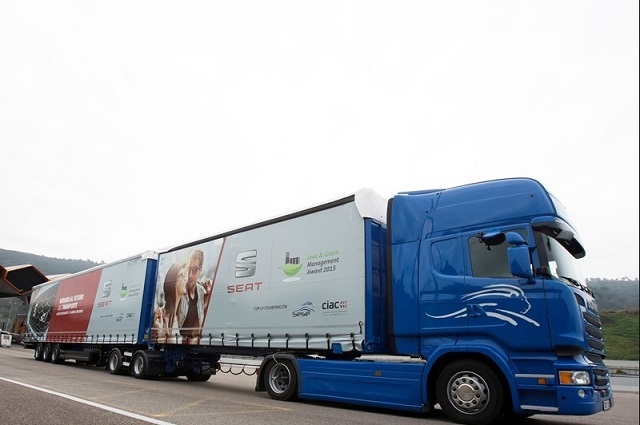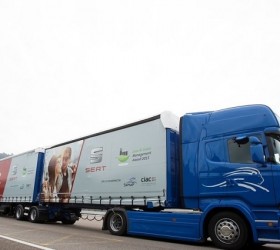A mega truck, a 25.25 metre long truck with a maximum hauling capacity of 60 tonnes has made its first Spanish road and motorway journey between Palau-solità i Plegamans (Barcelona) and Martorell. The maiden voyage was promoted by the Catalan Automotive Industry Cluster (CIAC) with the participation of SEAT as project leader, Grupo Sesé, CIMALSA, Grupo Carreras, Tecnicarton and SF Consultants.
 These companies have been working jointly in the CIAC Logistics Commission since June 2015 to carry out this pilot test aimed at demonstrating the viability of implementing mega trucks and asserting their regular use. In this sense, the truck was equipped with built-in sensors that monitored parameters for several systems on today’s route, especially related to safety aspects (braking, manoeuvrability, resistance of mechanical elements, etc.).
These companies have been working jointly in the CIAC Logistics Commission since June 2015 to carry out this pilot test aimed at demonstrating the viability of implementing mega trucks and asserting their regular use. In this sense, the truck was equipped with built-in sensors that monitored parameters for several systems on today’s route, especially related to safety aspects (braking, manoeuvrability, resistance of mechanical elements, etc.).
At this morning’s presentation at SEAT Martorell, CIAC President Vicenç Aguilera underlined:”We are very pleased to have achieved this milestone. It is the necessary first step in both improving logistics and transport and promoting competitiveness in our country”.He went on to say: “This project would not have been possible without the joint efforts made by the participating companies; an outcome that reaffirms our mission as a Cluster”.
SEAT Logistics director Enric Martí pointed out that: “We are very proud to lead this pioneering initiative in Spain, which will have a direct impact on the efficiency and sustainability of the logistics processes at the Martorell plant. The success of this pilot test makes us optimistic, and can therefore expect to cover three routes on the Iberian Peninsula with mega trucks in upcoming months”.
In response to this, Federico Ballester, the Transport Division director of Grupo Sesé, a supplier of SEAT and the company which purchased the mega truck, added: “Breakthroughs in logistics have to be made through innovation and technological development, and our aim as a company is to always be ahead of them. The tests that have been carried out with the mega truck put us in a privileged position and enable us to lead these new services. Nowadays we can assert that our customers are redesigning their logistics flows by relying on the mega truck and that we are ready to make them a reality”.
Also speaking at the event was Pere Padrosa, general director of Transport and Mobility of the Catalan Government’s department of Territory and Sustainability, who analysed the current situation of logistics and transport in Catalonia.
At the end of the presentation, Catalan Government minister for Territory and Sustainability Josep Rull led the welcome ceremony of the mega truck, built by Scania, arriving at SEAT Martorell on its first trip from Palau Automotive Manufacturing, a plant that belongs to Grupo Sesé located in Palau-solità i Plegamans (Barcelona).
The CIAC Logistics Commission asserts that the movement of mega trucks results in a 22% savings in logistics costs, lowering the price of each tonne of transported goods, as two mega trucks are equivalent to three conventional trucks. As stated by Aguilera this morning: “In addition to impacting both supplier and manufacturer, these cost savings benefit the entire value chain, improving the industry’s efficiency and competitiveness”.
The implementation of mega trucks also leads to energy savings and environmental improvement, as fewer trucks on the roads results in lowering CO2 emissions and polluting gases by 14%.
After this maiden voyage by road and motorway, the promoters of the project will continue to work on achieving regular use of mega trucks on Spanish roads. They can currently only travel with prior authorisation issued by the National Department of Traffic or by the Catalan or Basque traffic departments, which outlines the conditions governing the movement of these trucks. In Europe, mega trucks are already permitted to drive in Sweden, Finland, Denmark, the Netherlands, Portugal and some regions of Norway.




